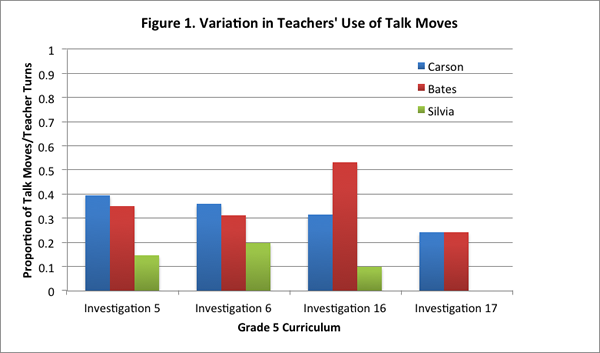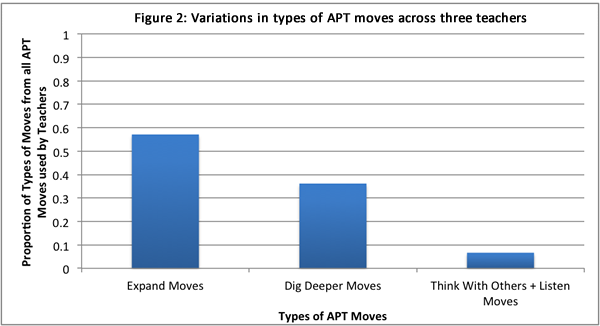Grade 5 Inquiry Project Curriculum Discussions 2011-2012
Summary of Classroom Discourse Findings
The analysis of the Grade 5 Inquiry Project curriculum discussions reveals how teachers guided students’ reasoning, and the various ways in which students engaged in the discussions. As stated before, the four lessons selected for videotaping and analysis each had a different kind of investigation and learning goals that shaped the emerging discussion. To better understand the findings, one needed to know the context of the discussions with respect to the underlying science investigations and learning goals. Therefore, we report here on each of the four discussions separately. Furthermore, within each discussion, we describe each teacher’s practice separately, documenting her facilitation and her students’ talk to identify similarities and variations among teachers’ practice, and to enable us to relate teachers’ practice to their students’ participation. Here we present a summary of the findings across the four discussions and three teachers from our analysis. Please refer to the NSF report for more details on the quantitative data from this analysis.
The findings show that teachers drew on various academically productive talk moves (APT moves) to guide their classroom discussions. They used the talk moves often to encourage students to expand their ideas, and to deepen their reasoning. The teachers also used talk moves to encourage students to listen and respond to their peers’ ideas, albeit to a much lesser extent. Overall, the findings indicate that while participating for the first time in the Talk Science professional development program, the teachers took on board the APT moves and incorporated various talk strategies into their classroom practice.
Further, in the case of two of the three teachers (Ms. Bates and Ms. Carson) examined in this analysis, their use of Expand and Dig Deeper sets of talk moves was aligned with the underlying purpose of the discussions, and varied with the different types of discussions. When the purpose of the discussion was to elicit students’ initial ideas about the process of evaporation (Investigation 6), the teachers utilized strategies to draw out students’ preliminary thinking (Expand Moves), and probed students less often to provide evidence and explanations (Dig Deeper Moves). On the other hand, when the purpose of the discussion was to encourage students to construct scientific explanations, the teachers utilized talk moves often to help students deepen their reasoning with the help of evidence and scientific principles. These findings suggest that the two teachers may have understood the different types of science discussions (elicitation, data, explanation, and consolidation) they were introduced to in the Talk Science program, and used talk strategies differently in leading their discussions to address the underlying learning goals. The present analysis, nevertheless, provides a quantitative overview of the classroom discourse; a more detailed examination is needed to clarify how the teachers adjusted their use of talk moves to the moment-to-moment interactions to accomplish differing goals of these discussions.
Our analysis revealed that students participated actively in various ways to make meaning of the science. To reason about the science, they drew often on their classroom investigations, referring to the experimental procedures and the data and observations gathered during the investigations. They included also formal scientific principles from the curriculum in generating their explanations. Additionally, students drew on ideas from outside the curriculum, incorporating everyday experiences, facts or opinions, analogies, and so forth as they tried to understand the science.
Furthermore, in two of the three classes (Ms. Bates’ and Ms. Carson’s), students’ reasoning with the help of ideas from within and outside the curriculum was fairly consistent with the type of discussion and the investigation framing the discussion. When the students did not have measurement data and the particle model to generate explanations (Investigation 6), they tended to invoke their everyday experiences, facts or opinions, and analogies to formulate their ideas. On the other hand, when students were provided with measurement data and a computer-based particle model (Investigation 5 and Investigation 16 respectively), they recruited these resources more often to construct explanations and reasoned less with the help of ideas and experiences from outside the curriculum.
Our examination of teachers’ practice showed also considerable variation among the teachers. One of the teachers (Ms. Silvia) used talk moves consistently less often than the other two teachers (Ms. Carson and Ms. Bates) (see Figure 1).

Further, there was variation in teachers’ use of different types of talk moves, with Ms. Bates using the Think With Others and Listen moves more often than the other two teachers. These differences notwithstanding, the general pattern was that teachers used more often talk moves designed to help mainly individual students explicate their ideas and deepen their own reasoning (Expand and Dig Deeper set of moves), and used much less often talk moves designed explicitly to foster active listening and co-construction of ideas by prompting students to attend carefully and respond to their peers’ thinking (Listen and Think With Others set of moves). (see Figure 2)

The low emphasis on using the Listen and Think With Others talk moves should be noted because overall the students also made few attempts at co-constructing science understandings with their peers. Further, students’ co-construction was generally consistent with the teachers’ use of Listen and Think With Others talk moves. Specifically, we observed that students tended to actively restate and respond to their peers’ ideas in discussions where the teachers utilized strategies to encourage them to engage with their peers’ thinking. Our findings suggest that students may need explicit teacher guidance to make meaning of the science collectively with their peers through a communal exchange of ideas. Students’ co-construction and teachers’ use of the Listen and Think With Others talk moves are critical in bringing about a dialogic exchange of ideas, where students go beyond sharing out their own ideas to building on their peers’ thinking, and work toward critiquing and refining the emergent shared understanding of the science within their classroom community.
Overall, our findings indicate that teachers’ participation in the Talk Science professional development program for the first time laid a foundation for developing their practice by including certain types of talk strategies into their teaching. Future research and design of professional development needs to explore ways to increase teachers’ facility at leading a more dialogic discourse to promote students’ scientific reasoning.



